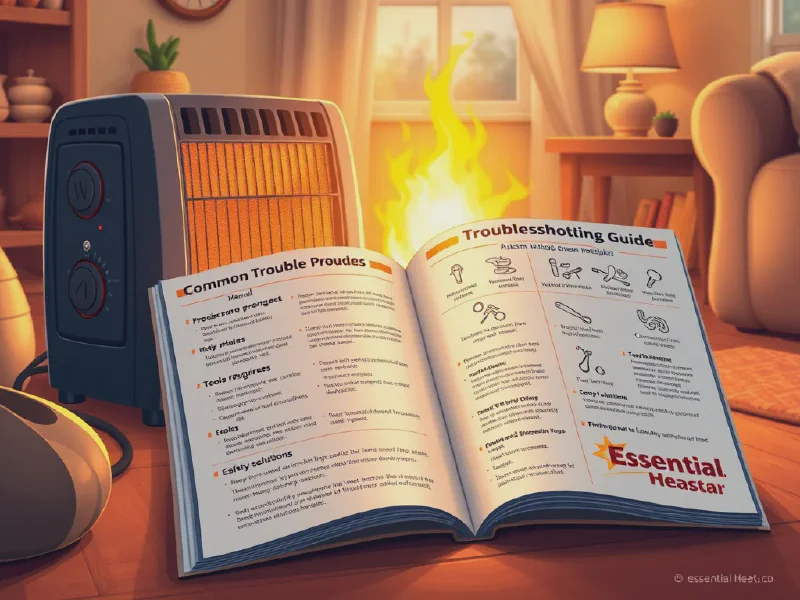Essential Heatstar Heater Troubleshooting Guide for You

Heatstar Heater Troubleshooting Guide
The Heatstar Heater Troubleshooting Guide is an essential resource for users facing issues with their heating systems. Understanding common problems and appropriate solutions helps ensure your heater operates efficiently and safely. Let's delve into common issues, maintenance tips, error code interpretations, DIY troubleshooting techniques, and vital safety precautions to keep your Heatstar heater in top condition.
Using the Heatstar Heater Troubleshooting Guide allows users to diagnose and resolve issues effectively. Routine maintenance and an understanding of how to interpret error codes can significantly reduce downtime. This guide equips you with knowledge of both common heater problems and the most effective fixes, enhancing your overall user experience.
Whether you are dealing with a heater that refuses to ignite or encountering unusual noises during operation, this Heatstar Heater Troubleshooting Guide offers practical solutions. Taking proactive steps can prevent major failures, keeping your environment warm and cozy during colder seasons.
By following the guidance contained within the Heatstar Heater Troubleshooting Guide, users can effectively manage their heating systems. Having a proactive approach to maintenance and troubleshooting empowers users, allowing for cost-effective and safe heater operation.
For homeowners and businesses relying on Heatstar heaters, familiarity with the troubleshooting process can save time and resources. This guide serves as a comprehensive tool designed to navigate through any heating inconsistencies you may face, ensuring peace of mind during operation.
Common Issues with Heatstar Heaters
One of the most common issues users face is the heater not igniting. This may be due to various reasons, including a faulty ignition system, lack of gas supply, or an empty fuel tank. Regular inspections and addressing these factors promptly can help users maintain optimal heating performance.
Another frequent complaint is uneven heating throughout the space. This can result from blocked vents, incorrect thermostat settings, or poor insulation in the room. Ensuring that the heater is adequately maintained and that all vents are clear is crucial to achieving consistent heat distribution.
Strange noises emanating from the heater can also indicate potential malfunctioning. These may include rattling, buzzing, or hissing sounds. Identifying the source of these sounds and addressing them promptly can prevent further damage or safety hazards.
Maintenance Tips for Heatstar Heaters
Regular cleaning procedures play a vital role in maintaining the efficiency of Heatstar heaters. Users should clean their heaters periodically to remove dust and debris that can hinder performance. This can involve vacuuming vents and cleaning the combustion chamber as per the manufacturer's recommendations.
Additionally, checking and replacing air filters is crucial to ensuring proper airflow. Dirty filters can restrict airflow, leading to inefficient heating and increased energy costs. Regular filter checks and replacements should be part of any maintenance routine.
Conducting functional checks before the winter season is essential. This includes testing the heater to ensure it operates correctly and safely prior to heavy usage, which helps identify and resolve issues before the heating demand peaks.
Error Codes and What They Mean
Understanding error codes displayed on your Heatstar heater can aid significantly in diagnostics. Many modern heaters come equipped with an error code function that points toward specific issues. Familiarizing yourself with these can streamline troubleshooting efforts.
Common error codes include those indicating ignition failure, overheating, and sensor malfunctions. Each code corresponds with a recommended troubleshooting approach, often detailed in the unit's user manual. Knowing these codes assists users in identifying the problem quickly.
When an error code presents itself, resolving issues related to specific codes often involves checking components such as sensors or ignitors and may require cleaning or replacing parts to restore functionality.
DIY Troubleshooting Techniques
A step-by-step guide to self-diagnosis involves checking the power supply, ensuring fuel availability, and inspecting for blockages. This systematic approach empowers users to identify issues before seeking professional help, potentially resolving the problem on their own.
Having the right tools is vital for effective troubleshooting. Common tools include multimeters, wrenches, screwdrivers, and vacuum cleaners. These tools assist users in completing basic repairs and maintenance efficiently.
However, there are specific circumstances when it's best to call a professional. If you've attempted troubleshooting without resolution or if you're uncomfortable performing repairs, seeking the help of a qualified technician is advisable to ensure safety and proper functionality.
Safety Precautions for Heater Use
Understanding the safety features of Heatstar heaters is paramount. These may include overheat protection, flame sensors, and emergency shut-off switches. Familiarizing oneself with these features ensures users are prepared in the event of an emergency.
Avoiding common hazards involves ensuring proper ventilation, not obstructing airflow, and regularly checking for gas leaks. Being vigilant about these factors enhances safety and prevents accidents associated with heater use.
Proper installation is also a crucial aspect of safety. Heaters should be installed according to manufacturer instructions and local regulations to minimize risk factors associated with improper setup.